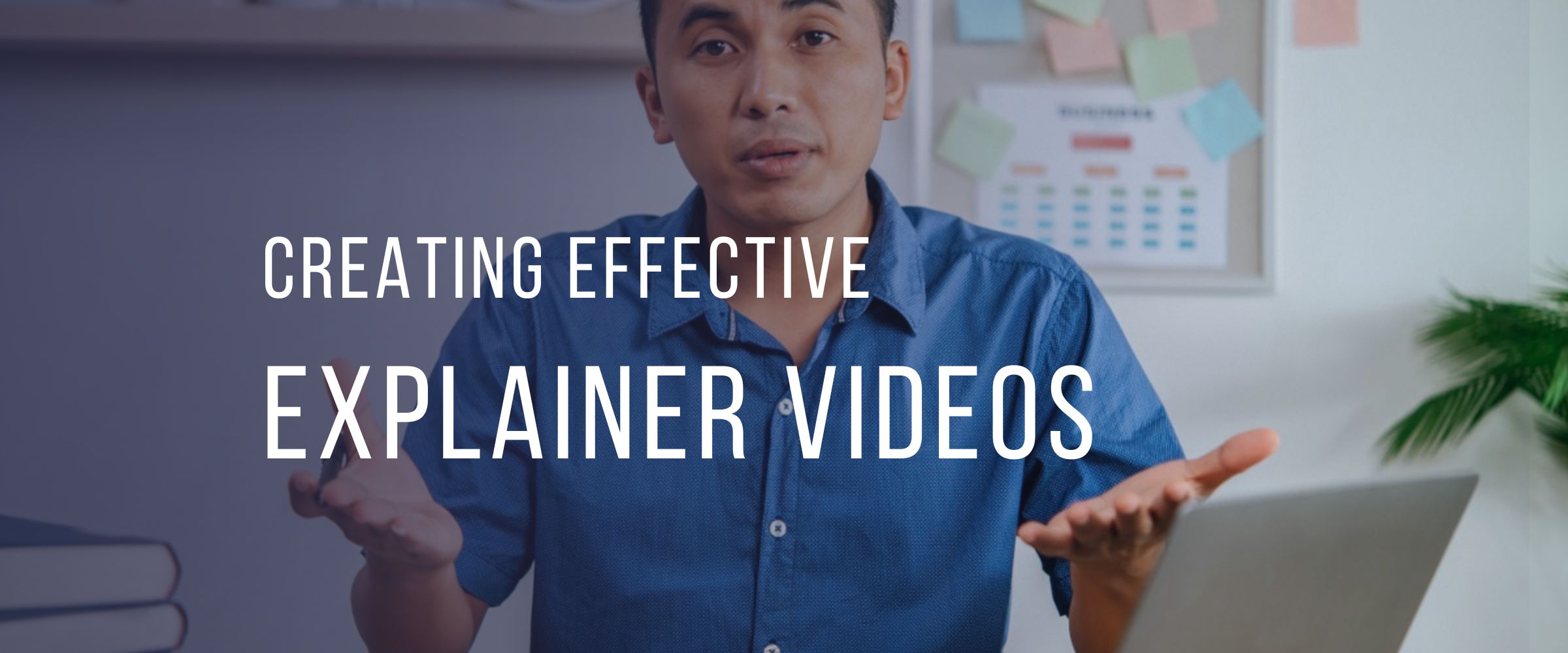Are you looking for an effective way to communicate your brand’s message to your audience? Look no further than explainer videos! These short, engaging videos have become a popular tool for businesses to explain complex ideas in a simple and entertaining way. Plus, explainer videos can also be done in a budget! In this blog, we’ll dive into everything you need to know to make an effective explainer video that suits your needs.
Selecting the Right Type of Explainer Video
Explainer videos come in a variety of types, each suited to different purposes and audiences. Choosing the right type of explainer video is crucial for businesses to effectively communicate their message to their target audience. The most common types of explainer videos include:
Animated Explainer Videos
These videos use animation and graphics to explain a product or service. They can be highly effective in simplifying complex concepts and keeping viewers engaged. Different animated treatments such as whiteboard, cut-outs, and motion graphics can be used to create different effects:

Source – conversion-uplift.co.uk
Whiteboard
Whiteboard animation is a popular animation technique where a hand draws out illustrations and text on a whiteboard. This creates a visually engaging and dynamic video. This treatment can be highly effective for explaining complex ideas or concepts and is often used for educational concepts or product demonstrations. For example, a company that offers software solutions may use whiteboard animation to create explainer videos that explains how their product works. The video may show the software’s key features, with the artist drawing images and text on the whiteboard to illustrate the concepts.

Source-Houston public media
Cut-out
Cut-out animation involves animating characters and objects cut out from paper or card. It’s a unique and eye-catching technique that can be highly effective in capturing attention. This technique is often used in explainer videos for children’s products or services, as it has a playful and whimsical feel that can capture their attention. For instance, a toy company may use cut – out animation to create an explainer video for a new product line aimed at children. The video may feature brightly coloured cut-out characters that move across the screen, interacting with the toys and demonstrating their features.

Source – school.mangoanimate.com
Motion Graphics
Motion graphics use moving text, graphics, music and voice-over to create a visually interesting video. They’re a great way to showcase data and statistics in an engaging way. This treatment is commonly used in explainer videos for startups or organizations looking to showcase data or statistics in a visually engaging way. It can also be effective for introducing new products or services. A financial institution may use motion graphics to create an explainer video about their investment products. The video may include charts and graphs that illustrate the performance of various funds, with animated elements that highlight key data points. The animation could also include a voiceover that explains how the products work and what benefits they offer to investors.
Take a look at the educational video production we did for our client, DSP Mutual Fund, where we incorporated motion graphics in certain sections to enhance the content.
Live-Action Explainer Videos
Live-action explainer videos use actors or real people to demonstrate a product or service. These videos can be highly effective in building trust and credibility with viewers. These videos are often used by service-based businesses to build trust with potential clients. For example, in this product video shoot for our client Barosi, the founder provided a detailed explanation of the manufacturing process for their pickle products.
Screencast Explainer Videos
Screencast explainer videos are a simple and cost-effective way to explain software or digital products. They use screen recording software to capture a step-by-step process.
Take a look at the screencast explainer video demonstrating how to add team members as a creator on MediaFlow, our project management platform for video production.
It’s important to consider the nature of the product or service, the intended audience, and the message to be conveyed when deciding on the type of explainer video to use.
Using Stock Videos
Using Indian stock footage in explainer videos can be an effective way to add visual interest and depth to your video without breaking the bank. Stock footage refers to pre-existing video clips that can be licensed for use in your video.
One of the biggest benefits of using stock footage is that it can save you time and money. Instead of having to shoot new footage or create animations from scratch, you can simply license existing footage that fits your needs.
Check out the ad film we made for our client, Adishtu, where we utilized stock footage in the initial shots.
There are many stock footage websites available online where you can find footage on almost any topic imaginable. This can be particularly helpful if you need to incorporate footage that you don’t have access to yourself.
When using stock footage, it’s important to choose footage that is high quality and relevant to your message. You also want to make sure that the footage fits seamlessly into your overall video, both in terms of visual style and content.
Choosing the right music and voice-over
Music can play a crucial role in the success of an explainer video. It can set the tone and mood of the video and help to keep viewers engaged. Here are some tips for choosing the right music for your explainer video:
Match the tone of the video – The music should match the tone of the video. If the video is light-hearted and fun, choose music that reflects this.
Use royalty-free music – Using copyrighted music can be expensive and may result in legal issues. Instead, use royalty-free music that won’t land you in trouble.
In addition to music, the voice-over is another important aspect of an explainer video. It’s essential to have a clear and concise voice-over that complements the visuals and helps to convey the message effectively. Here are some tips to keep in mind when selecting a voice-over artist:
Matching the tone – Just like with music, the voice-over artist’s tone should match the tone of the video. If the video is serious and professional, choose a voice-over artist with a similar tone.
Use a professional voice-over artist – While it may be tempting to have someone on your team do the voice-over, it’s crucial to use a professional voice-over artist. A professional voice-over artist has the experience and expertise to deliver the message effectively and can provide high-quality audio.
Keep it concise – The voice-over should be concise and to the point. Avoid using unnecessary words or phrases that can distract the viewer from the message.
Overall, the music and voice-over can make or break an explainer video. It’s essential to choose the right music and voice-over artist that matches the tone of the video and effectively conveys the message. Also, a good video production company might be able to help you with that.
Need a Company Profile Video, An Explainer Video, or a Product Shoot?
We’ve got a fantastic pool of experienced video creators from across India.
Whatever kind of video you need, we’ll get it done. Whatever your budget.
Understanding the Psychology of Explainer Videos
The psychology of explainer videos is a fascinating area that can help businesses make their videos more persuasive and effective. Here are some cognitive principles that can be used to create more compelling explainer videos:
Attention: The human brain has a limited attention span, so it’s important to grab the viewer’s attention quickly. This need for quick engagement has led to the rise of 30-second explainer videos among brands. Use attention-grabbing visuals and engaging music to draw viewers in and make them want to watch the video. For example, in an explainer video for a new mobile app, starting the video with a dynamic visual of the app’s user interface and playing upbeat background music can help grab the viewer’s attention within the first few seconds.
Memory: People are more likely to remember information that’s presented visually and verbally. Use a combination of text, images, and voice-overs to help viewers retain information. For example, in an explainer video for a cooking class, using a combination of text, images, and voice-over to explain the steps of a recipe, will help viewers remember the instructions.
Emotion: Emotions play a powerful role in decision-making, so it’s important to create an emotional connection with viewers. Use stories, humour, or other emotional triggers to make viewers feel invested in the video’s message. For example, in an explainer video for a charity organization, telling a story about someone who was helped by the organization’s work, will create an emotional connection with viewers and make them feel invested in the cause.
Social Proof: People are more likely to trust a product or service if they see others using it. Incorporate customer testimonials or other forms of social proof to demonstrate the value of your offerings. For example, in an explainer video for a new fitness program, including testimonials from people who have successfully completed the program and achieved their fitness goals, will demonstrate the value of the program and encourage viewers to sign up.
Call-to-Action: A clear call-to-action at the end of the video can help viewers take the next step. Use phrases like “sign up now” or “learn more” to encourage viewers to engage with your brand.
By understanding the psychology behind how people consume and process information, businesses can create explainer videos that are more persuasive and effective. Utilizing these cognitive principles can help ensure that your video resonates with viewers and drives results for your business.
An effective explainer video production requires a thoughtful approach that focuses on the audience, the message, and the visuals. By identifying the key points, using storytelling techniques, and keeping it simple, you can create a video that is engaging, memorable, and persuasive. Don’t forget to also pay attention to the details such as the script, voice-over, and animation to ensure a polished final product.









